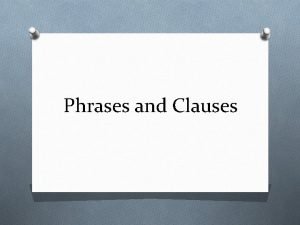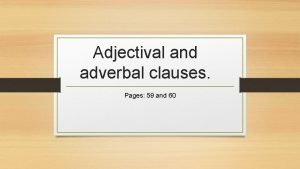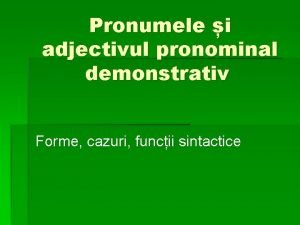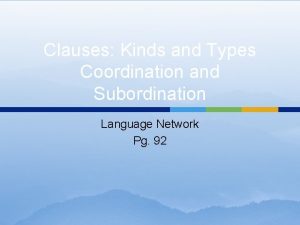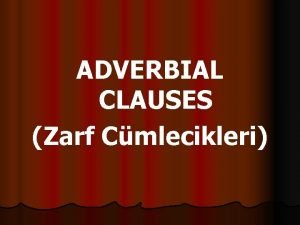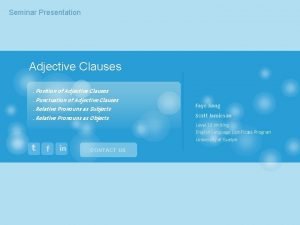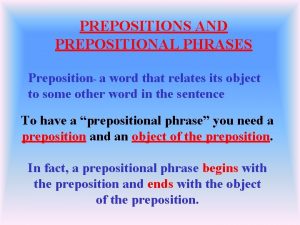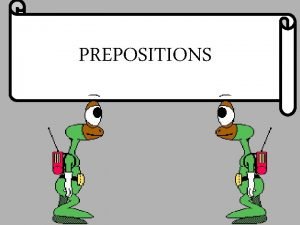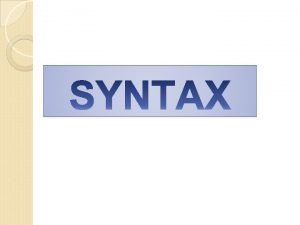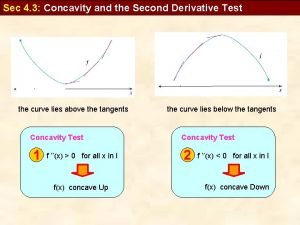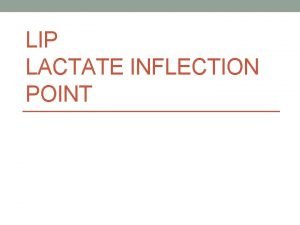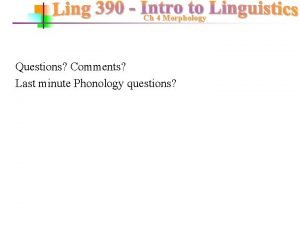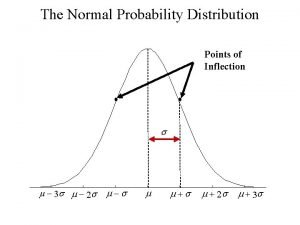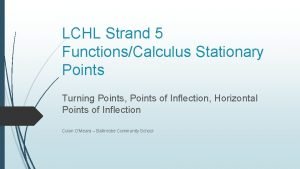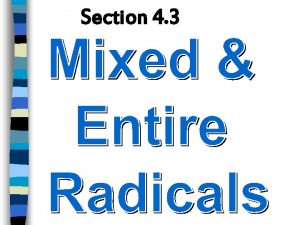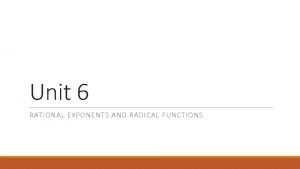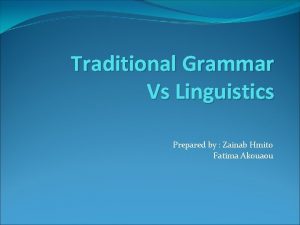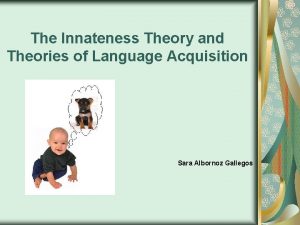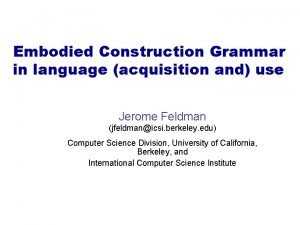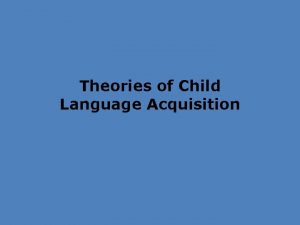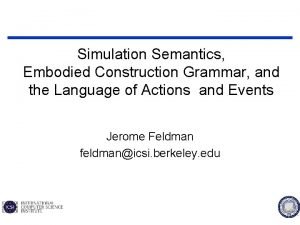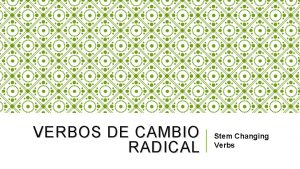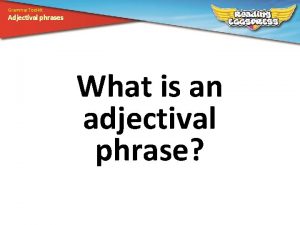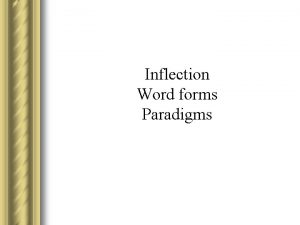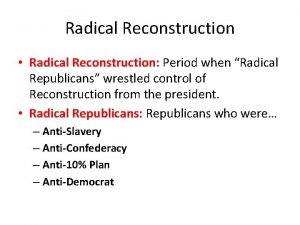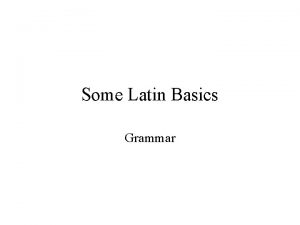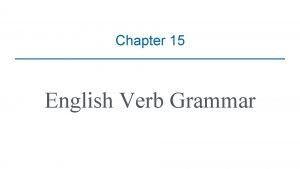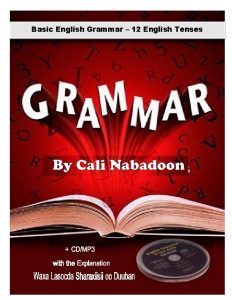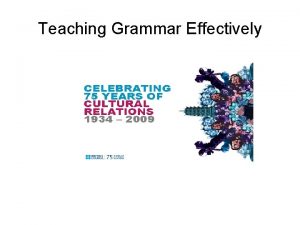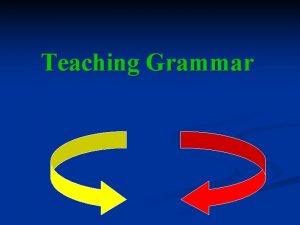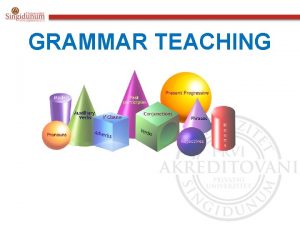English Adjectival Inflection A radical Radical Construction Grammar









































- Slides: 41

English Adjectival Inflection: A radical Radical Construction Grammar Approach John Newman & Sally Rice University of Alberta CSDL 2006 UC San Diego

Bertrand Russell’s Emotive Conjugations singular 1 I’m tenacious 2 you’re stubborn 3 he’s pigheaded

inflection-specific adjectival meaning and behavior in English

a radical Radical Construction Grammar approach language-specific (typologically aware) construction-specific (context sensitive) inflection-specific (lemma sceptical)

a radical Radical Construction Grammar approach language-specific (typologically aware) construction-specific (context sensitive) inflection-specific (lemma sceptical)

English Adjectival Inflection inflectional periphrastic suppletive positive tall interesting good comparative taller more interesting better superlative tallest most interesting best

English Adjectival Inflection –– FACTORS semantics etymology / derivation syllable structure phonotactics register / dialect (Quirk & Greenbaum, Kytö & Romaine 1997, Biber et al. 1999 )

English Adjectival Inflection –– FACTORS semantics etymology / derivation syllable structure (Quirk & Greenbaum, Kytö & Romaine 1997, Biber et al. 1999 ) phonotactics register / dialect inflectional island effects (Rice & Newman 2005)

Inflectional Islands Syntactic (constructional), semantic, and collocational properties tend to inhere in individual inflections of a lexical item in a register-specific manner. These properties may not extend across all the inflections (the paradigm) to characterize the lemma as a whole.

THE VERB ISLAND HYPOTHESIS THE INFLECTIONAL ISLAND HYPOTHESIS Tomasello 1992, 2004 Rice & Newman 2005 V <<< V inflection >>> inflection l children tend to use uninflected verb roots before inflected forms l adults use particular inflected forms of individual verbs on a register-specific basis l verb inflections are mastered on a verb-by-verb basis l verb inflections adhere to verbs on a verb-by-verb basis l generalization is gradual l particularization is gradual l initially, particular verbs “strand” inflections l eventually, inflections “strand” particular verbs

DISTRIBUTION OF SOME BASIC VERBS IN THE BNC BASED ON TAM INFLECTION

IMPLICATIONS OF USAGE-BASED APPROACHES TO GRAMMAR a new starting point for linguistic analysis put lemmas aside (as done earlier with syntactic rule in favor of constructions) substitute words-in-context or WICs (intersection of genre, register, & inflection) a new (lower) level of linguistic generalization find the “hierarchy of lower-level structures. . . [that] specify the actual array of subcases and specific instances that support and give rise to the higher-level generalization” RWL, Concept, Image, & Symbol, 1991: 281 -282

WICs locus of lexicalization and grammaticalization active in borrowings and morphological realignment spawn psychological associations, induce priming effects

English Inflected Adjectives as WICs uneven distribution alternate marking newer more new double marking bestest most commonest inflectional gaps sheer *-er inflectional idiosyncracies irregular semantics collocational preferences of WICs constructional properties of WICs sheerest

English Inflected Adjectives as WICs uneven distribution alternate marking newer more new double marking bestest most commonest inflectional gaps sheer *-er inflectional idiosyncracies irregular semantics collocational preferences of WICs constructional properties of WICs sheerest

Our focus here 1. Inflectional idiosyncracies (relative frequencies) 2. N collocates 3. A collocates 4. Constructions

1. Inflectional idiosyncracies of A, Aer, Aest

1. Inflectional idiosyncracies of A, Aer, Aest BEST

1. Inflectional idiosyncracies of A, Aer, Aest

1. Inflectional idiosyncracies of A, Aer, Aest

1. Inflectional idiosyncracies of A, Aer, Aest

1. Inflectional idiosyncracies of A, Aer, Aest

2. N collocates of A, Aer, Aest

2. N collocates of A, Aer, Aest

2. N collocates of A, Aer, Aest

2. N collocates of A, Aer, Aest

2. N collocates of A, Aer, Aest

2. N collocates of A, Aer, Aest

2. N collocates of A, Aer, Aest

3. A collocates of A, Aer, Aest

4. Misc. constructions with A, Aer, Aest It is _____ to. . .

4. Misc. constructions with A, Aer, Aest It is _____ to. . .

4. Misc. constructions with A, Aer, Aest It is _____ to. . .

4. Misc. constructions with A, Aer, Aest A-er than NORM

4. Misc. constructions with A, Aer, Aest A-er than NORM

a radical RCG approach to English adjectival inflection A and A A-er and A-er A-est and A-est more A and more A most A and most A even A-er even more A A-er N A-est N more A N most A N N be A-er N be A-est N be more A N be most A

A radical RCG approach to allows us to leave the paradigm behind. Paradigms (lemmas) have value for some purposes, but they often end up straight-jacketing an analysis. The conceit of the paradigm tends to dull our interest in looking at the lexical semantics of inflected forms in their own right (cf. the Russellian conjugations). Some items do escape the shackles of the

l A radical RCG approach to allows us to leave the paradigm behind. l Paradigms (lemmas) have value for some purposes, but they often end up straight-jacketing an analysis. l The conceit of the paradigm tends to dull our interest in looking at the lexical semantics of inflected forms in their own right. l Some items do escape the shackles of the paradigm and actually become lexical items in their own right (cf. the Russellian conjugations).

a radical RCG approach to English adjectival inflection rath(e) rather rathest nigh near next former first later nearest foremost latest

a radical RCG approach to English adjectival inflection rath(e) rather rathest nigh near next former first later nearest foremost latest

Thank you.
 Azeotropic copolymerization
Azeotropic copolymerization Initiator 화학
Initiator 화학 Adjectival and adverbial phrases
Adjectival and adverbial phrases Adjective phrase example
Adjective phrase example Adjective phrases
Adjective phrases Adverbal
Adverbal Qet in ipcr
Qet in ipcr Atribut pronominal genitival exemple
Atribut pronominal genitival exemple Adjective dependent clause
Adjective dependent clause Relative clause
Relative clause Attributive adjectives german
Attributive adjectives german Kind of dependent clause
Kind of dependent clause Adverbial clause of reason
Adverbial clause of reason Position of adjective
Position of adjective Preposition and prepositional phrase
Preposition and prepositional phrase A word that shows the relationship between
A word that shows the relationship between Structure of adjective phrase
Structure of adjective phrase Sec derivative
Sec derivative Lactate inflection point
Lactate inflection point Blending in morphology
Blending in morphology Normal curve inflection points
Normal curve inflection points Types of turning points
Types of turning points Voice inflection
Voice inflection Genitiv
Genitiv Radical terminology
Radical terminology Unit 6 radical functions homework 4 rational exponents
Unit 6 radical functions homework 4 rational exponents Entire radical
Entire radical Left-linear grammar
Left-linear grammar Weakness of traditional grammar
Weakness of traditional grammar Unrestricted grammars
Unrestricted grammars Right linear grammar to left linear grammar
Right linear grammar to left linear grammar Active construction of a grammar theory
Active construction of a grammar theory Embodied construction grammar
Embodied construction grammar Active construction of grammar theory
Active construction of grammar theory Embodied construction grammar
Embodied construction grammar Verbos de cambio radical in english
Verbos de cambio radical in english English paragraph reading
English paragraph reading Past simple englex
Past simple englex Basic english grammar test
Basic english grammar test Swabi subordinating conjunction
Swabi subordinating conjunction V present
V present Kahoot grammar review
Kahoot grammar review



